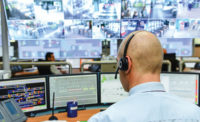Some facilities are plagued with hundreds of nuisance alarms every week. Outdoor detection systems, which must operate in an uncontrolled environment subject to weather changes, random movements from trees, shadows from clouds, and small animals that can inappropriately trigger alerts, are especially prone to nuisance alarms. One cause of these nuisance alerts in outdoor systems comes from deploying intelligent video systems originally designed for static indoor environments. When these indoor systems are misapplied to protect a facility's perimeter or buffer zone, the recurrence of nuisance alarms can undermine the important mission of perimeter security to serve as the first line of defense.
Often the only option left in such cases is to decrease the system’s detection sensitivity in order to decrease the number of nuisance alerts. As a result, there is a high likelihood that such systems will never detect the threats that they were intended to stop.
For these reasons, providing effective outdoor security systems without nuisance alarms or misdetects requires intelligent surveillance systems designed for outdoor applications. A number of camera features engineered specifically for outdoor surveillance enables such a system to provide accurate detection in the outdoor environment, despite uncontrolled factors. For example, sufficient on-board image processing can be used to accurately discriminate legitimate targets from extraneous surrounding motion and clutter. Such processing power within the camera can be used to stabilize the image electronically, before video content analysis takes place. This removes camera motion as a source of nuisance alarms or misdetects, since video analytics software cannot detect an object entering into view if the whole scene is moving from wind. Sufficient in-camera processing can also eliminate water reflections and tree motion as sources of nuisance alarms, and dynamically correct lighting to detect events that would otherwise be missed. Additional environmental factors that need to be addressed in the outdoors include the sun moving across the sky, clouds constantly in motion and shadows moving through a scene, all of which must be filtered so as not to appear to the camera as targets on which to alarm.
When sufficient processing is placed directly within the camera, 100 percent of the raw scene data is available to make accurate determinations, data that would otherwise be stripped away for transmission over the network for external analysis. Such extra processing can also be used to georegister the camera's field-of-view to GPS coordinates and provide operators with accurate determination of target location, size, bearing and speed, information which is not needed for indoor surveillance but becomes critical when protecting large outdoor areas.
The economics of covering large outdoor areas is also different. Outdoor surveillance involves additional infrastructure costs, including engineering design, construction, trenching, camera poles, network connectivity, video display and storage. By providing the appropriate level of computational power, such outdoor cameras are able to cover great distances, as much as three to five times the distance (more than ten times the area) of indoor surveillance cameras, reducing the number of cameras, infrastructure and associated costs. While outdoor cameras may have a higher cost per unit, their extended range from extra processing leads to an overall reduction in deployment cost.
Applying outdoor solutions to outdoor problems is the key to eliminating nuisance alarms. Using appropriate tools designed for the task enables the full realization of the long-promised benefits of intelligent video – and delivers new levels of efficiency for the $100 billion security guard market.








